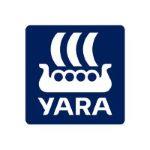The world’s first ship-to-ship transfer of ammonia using vessels at anchorage in a working port environment has been completed. The transfer is a significant step towards realizing ammonia as a shipping fuel and enable bunkering worldwide. Yara contributed with their experience and knowledge on safe handling of ammonia, nominated an ammonia vessel from their Time Charter fleet, and the ammonia used in the transfers.
“This demonstrates that ammonia transfer can be done with the highest safety standards and efficiency in a working port environment. The transfer is a major milestone to decarbonize shipping using low-emission ammonia as fuel,” says Murali Srinivasan, SVP Commercial Yara Clean Ammonia.
The operation is a result of the collaborative relationship between Yara Clean Ammonia, Pilbara Ports Authority and the Global Centre for Maritime Decarbonisation (GCMD). It was conducted in Port Dampier in Western Australia’s Pilbara region, as part of the work to enhance the Pilbara’s potential as a bunkering hub to fuel ships with low-emission ammonia. Low-emission ammonia is produced with renewable energy and electrolysis of water or with carbon capture and storage. Ammonia does not emit CO2 when burned.
The Pilbara Ports Authority and Yara Clean Ammonia have been working together for more than two years investigating the potential demand for ammonia as a fuel, required bunker infrastructure, safety guidelines and the required regulatory framework. To develop the transfer, this partnership was expanded with GCMD, who successfully attracted additional partners to help ensure a safe and efficient execution of the transfer operation. Port Dampier has ongoing experience with ammonia cargoes with Yara Pilbara’s nearby operations shipping an incident free 11.8 million tonnes to date.
The two ship-to-ship transfers were undertaken between the Green Pioneer, 35,000 cubic metres (cbm) ammonia carrier (owner MOL), and the Navigator Global, a 22,500 cbm ammonia carrier (owner Navigator Gas). The trial involved a dual transfer of 4,000 cbm (approximately 2,715 tonnes) of ammonia, first from the Green Pioneer to the Navigator Global, and then back to the Green Pioneer.
Murali Srinivasan, SVP Commercial Yara Clean Ammonia said collaboration on safety is innate to our thinking and we are very proud to be part of this tripartite project and active collaboration and contributions to the positive outcome of the trials.
"International shipping accounts for 3% of the global GHG-emissions and we see clean ammonia as the low to zero-emission fuel to decarbonize the shipping industry and meet the International Maritime Organization (IMO) targets. For more than a century we have been producing and shipping ammonia with the highest safety standards and efficient ammonia operations. The successful ship-to-ship transfer of ammonia was a critical learning step in enabling ammonia bunkering operations in a port environment as global shipping moves to effective use of ammonia as a fuel,” says Mr. Srinivasan.
“We thank all partners that were involved and highly appreciate the leadership of GCMD in bringing frontrunners together as well as the Pilbara Port Authority for their facilitation and guidance. Of course, additional thanks are due specifically to the team of YCA and the Yara Pilbara plant involved in this significant step towards ammonia bunkering," says Murali Srinivasan.
Yara Pilbara’s Chief Operations Officer Laurent Trost said the successful trials were extremely encouraging as the Pilbara operations moves forward with key decarbonization measures.
“We currently have the Project Yuri renewable hydrogen demonstration plant under construction on our existing lease which will begin injecting green molecules into our ammonia production process next year, and we are also investigating carbon capture and storage which would swiftly and significantly cut carbon output from our operations,” Mr. Trost says.
“These measures, along with government planning for enablement of green electricity transmission, would allow us to develop low carbon ammonia products in the Pilbara for application in the shipping industry and other clean fuels, as well as the building block for decarbonized ammonium nitrate and fertiliser products,” Mr Laurent Trost says.
**Additional media materials including an extended media release on the trial and images are available through the following link https://www.gcformd.org/successful-ship-to-ship-ammonia-transfers-pave-the-way-for-ammonia-bunkering-in-the-pilbara-region/
About Yara Clean Ammonia
Yara grows knowledge to responsibly feed the world and protect the planet. Yara Clean Ammonia is uniquely positioned to enable the hydrogen economy in a market expected to grow substantially over the next decades. We aim at significantly strengthening our leading global position as the world’s largest ammonia distributor, unlocking the green and blue value chains, and driving the development of clean ammonia globally.
Building on Yara’s leading experience within global ammonia production, logistics and trade, Yara Clean Ammonia works towards capturing growth opportunities in low-emission fuel for shipping, power generation, low-carbon food production and ammonia for industrial applications.
Yara Clean Ammonia operates the largest global ammonia network with 15 ships and has, through Yara, access to 18 ammonia terminals and multiple ammonia production and consumption sites across the world. Revenues and EBITDA for the FY 2023 were USD 1.9 billion and USD 101 million respectively. Yara Clean Ammonia is headquartered in Oslo, Norway www.yaracleanammonia.com
About Yara Pilbara
In the Pilbara, Yara has created a world class downstream processing precinct. The Yara Pilbara Fertilisers plant is a world-scale facility and the ammonia it produces is exported to global markets mainly for use in fertilisers. The Yara Pilbara Nitrates technical ammonium nitrate plant is a joint venture with Orica which converts ammonia into a material crucial for unlocking the wealth of Western Australia’s mining industry. The company has 220 residential Karratha-based employees.
Yara Clean Ammonia Contact
Hilde Steinfeld
+47 99 35 30 30
hilde.steinfeld@yara.com
Yara Pilbara Media Contact
Casey Cahill
0413 992 195
casey@counselcomms.com.au
Attachments
- Navigator Global and the Green Pioneer
- The Green Pioneer and the Navigator Global with tugboats
- Representatives of the tripartite

